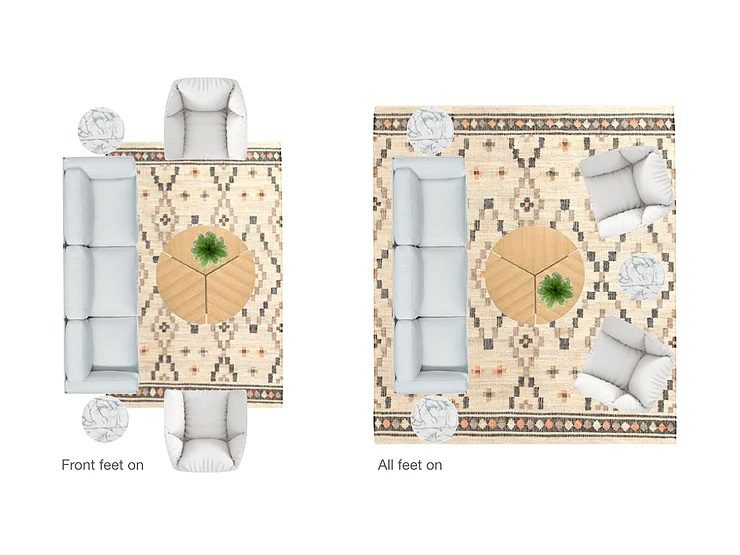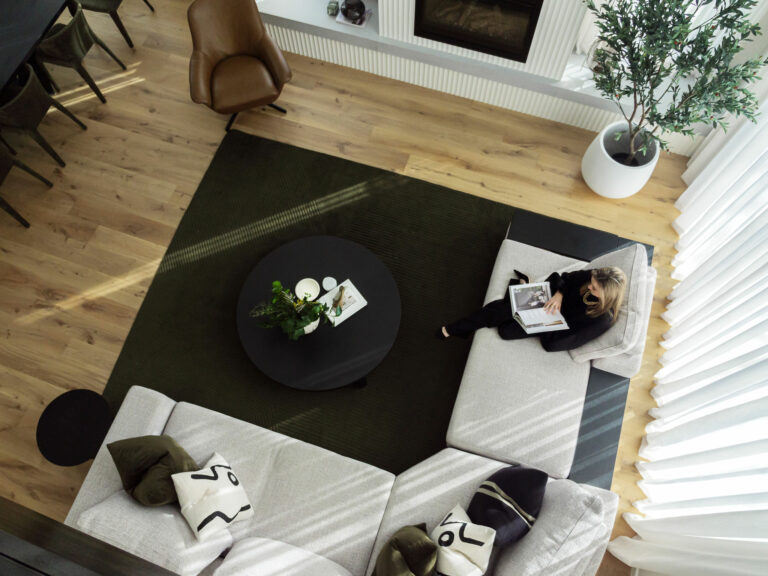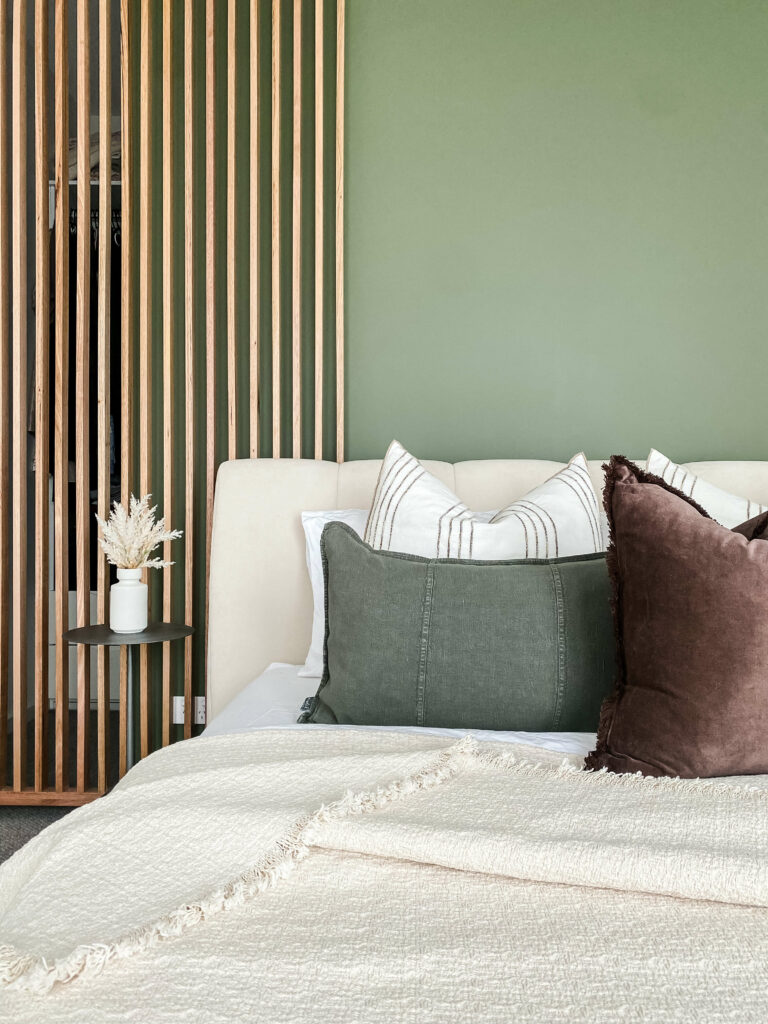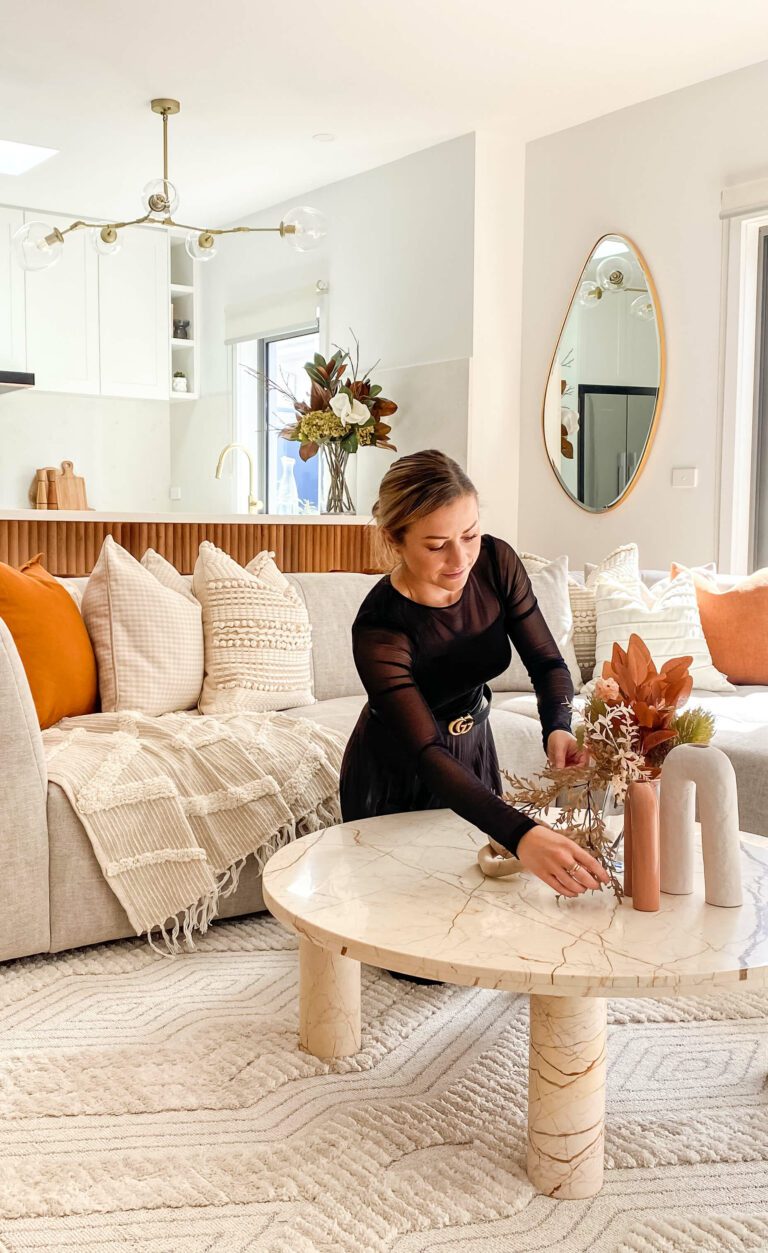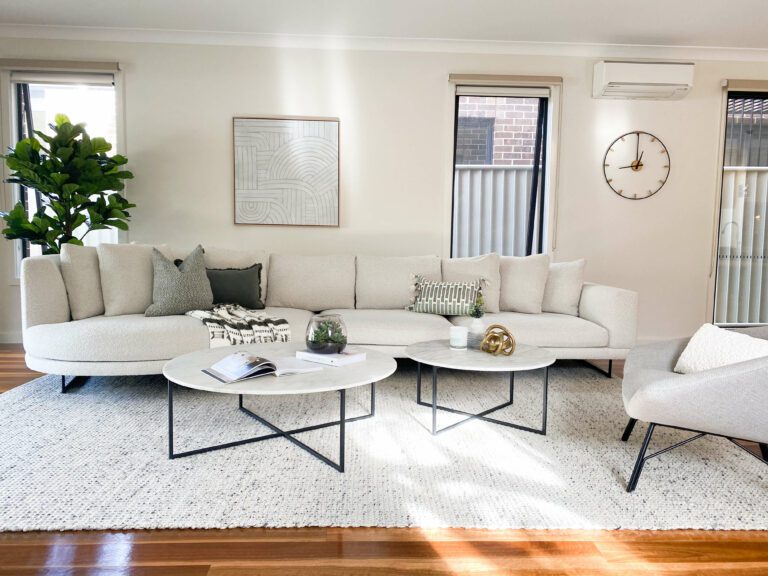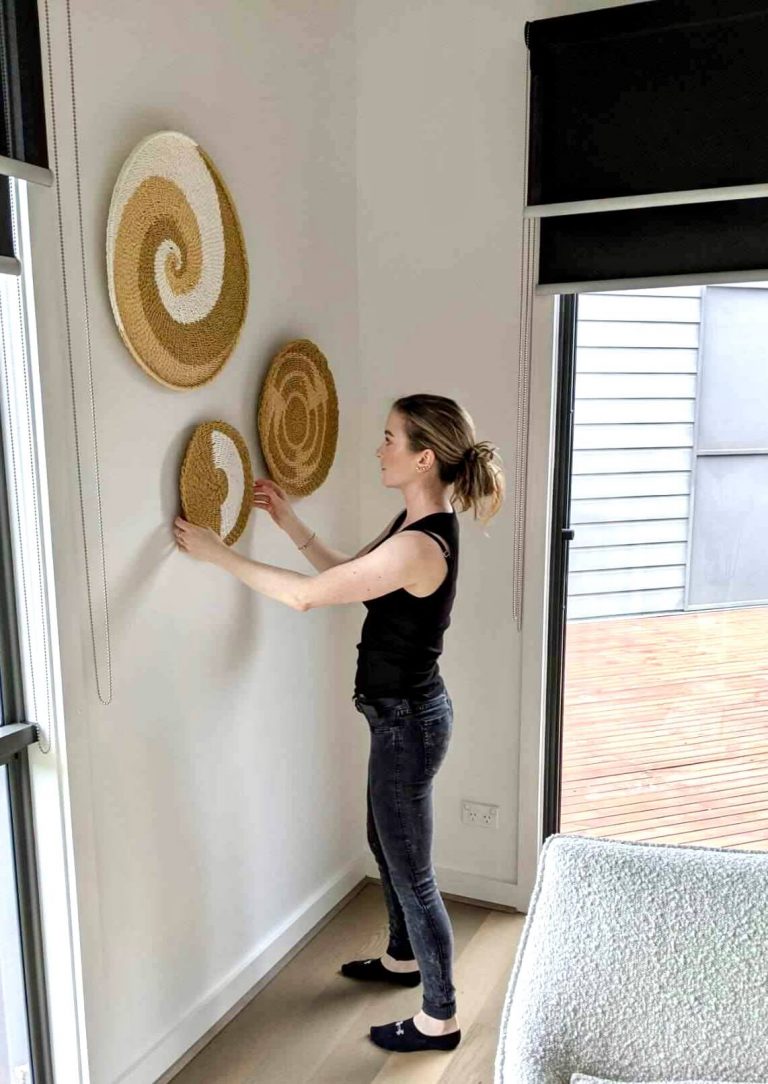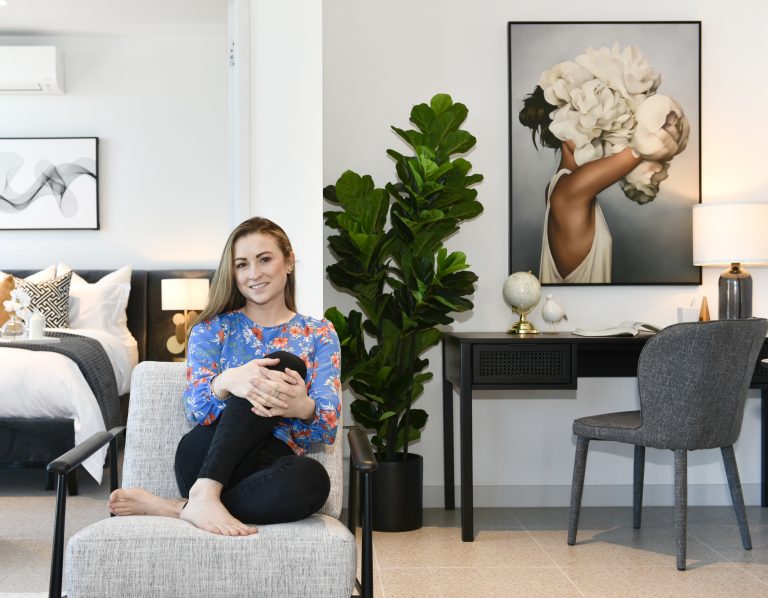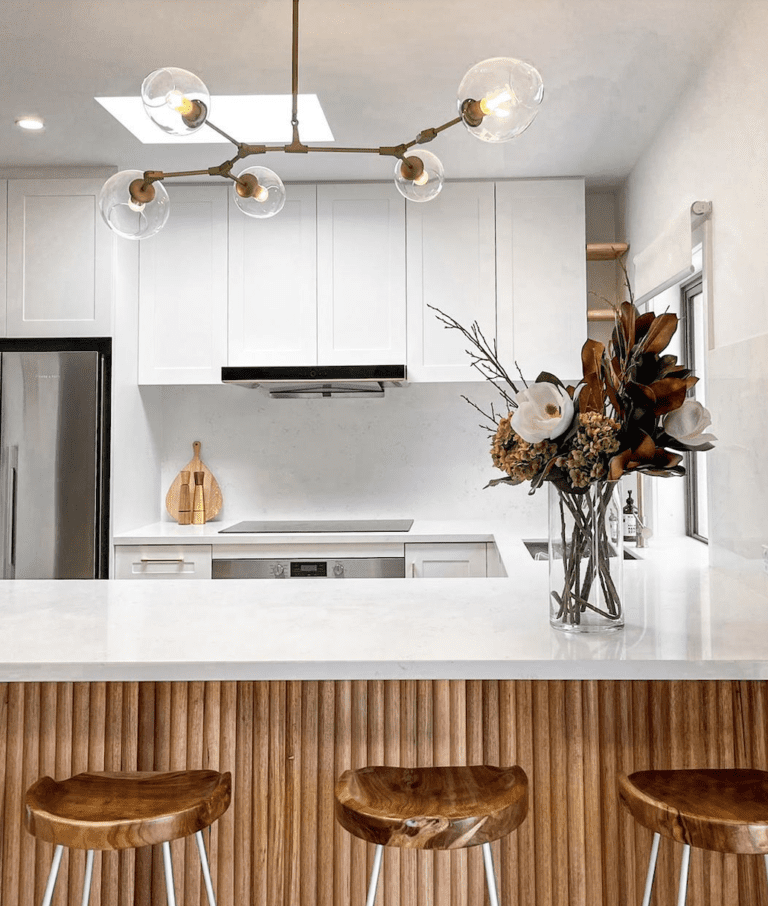Rugs fulfil a vital function in defining zones and areas, adding a sense of coziness, separation, and enclosure within a room. They function as intangible walls, effectively creating an additional space for you to enter. By incorporating rugs, you can bring harmony to a room through matching colours or introduce captivating textures to enhance your surroundings. A room lacking a rug is akin to artwork without its frame – it remains incomplete!
What size rug should I choose?
This is one of the most important questions to ask yourself once you have furnished your space. In my opinion, rugs are not optional in interior design, they are necessary. They should not be an afterthought, they should be well-planned and complementary to your room.
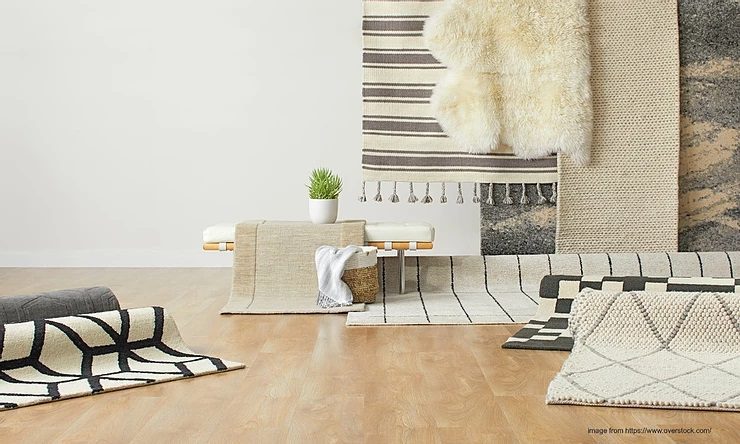
What rooms should you buy rugs for?
Rugs are commonly acquired for living rooms, bedrooms, rumpus rooms, home offices, and occasionally for dining rooms. However, the use of rugs in dining rooms can be a matter of personal preference. Some people prefer not to have rugs under the table due to concerns about food particles getting trapped in the fibres, which can be unhygienic. However, in certain cases, rugs are used in dining rooms to add visual interest, break up wood tones, or prevent clashes between the table and floor surfaces.
To brighten up a room with limited natural lighting and a dark floor, a smart solution is to introduce a light-coloured rug underneath the table. This will help uplift the overall ambience of the space. Similarly, if your dining area is part of a larger open-plan layout and you desire to establish a distinct “dining room” zone, placing a rug under the dining table can effectively achieve this goal.
I love the idea of placing a rug underneath the bed as it brings a cozy touch to the space. Don’t worry about a rug on the carpet – it works perfectly fine! You can position a snug rug under your bed, at the foot of the bed, or even place two rugs on either side. Your feet will greatly appreciate it, especially on chilly winter mornings when it’s a challenge to leave the warmth of your bed.
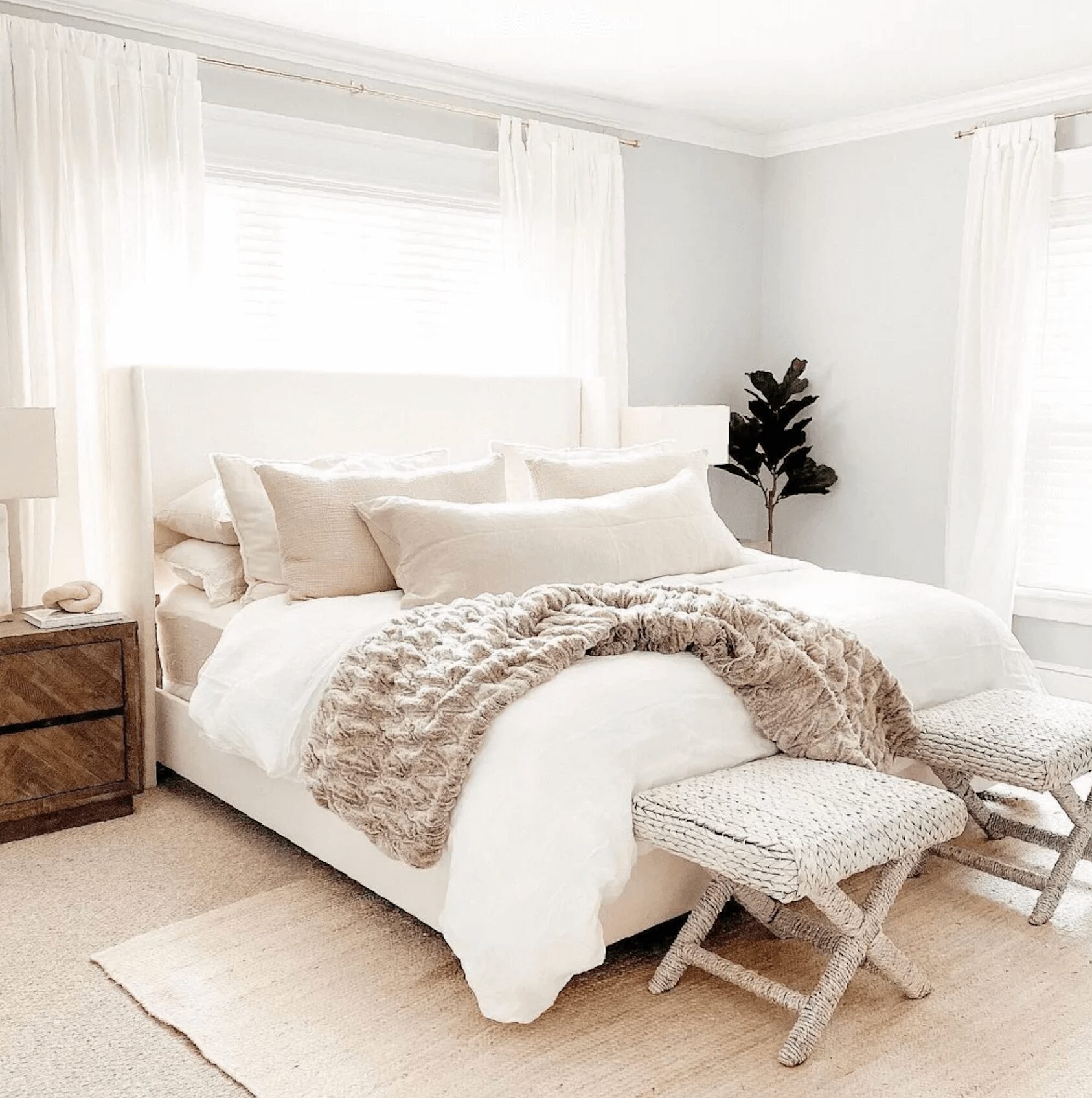
“A rug in your living room is simply non-negotiable. It anchors that setting and zones it as the relaxing spot”.
Depending on the size of your rooms, you can also consider a rug for your laundry, a walk-in robe (if you have one like Mariah Carey on MTV Cribs), your outdoor verandah or even the bathroom. There are special materials for outdoors and also for wet rooms which look spectacular in large bathrooms!
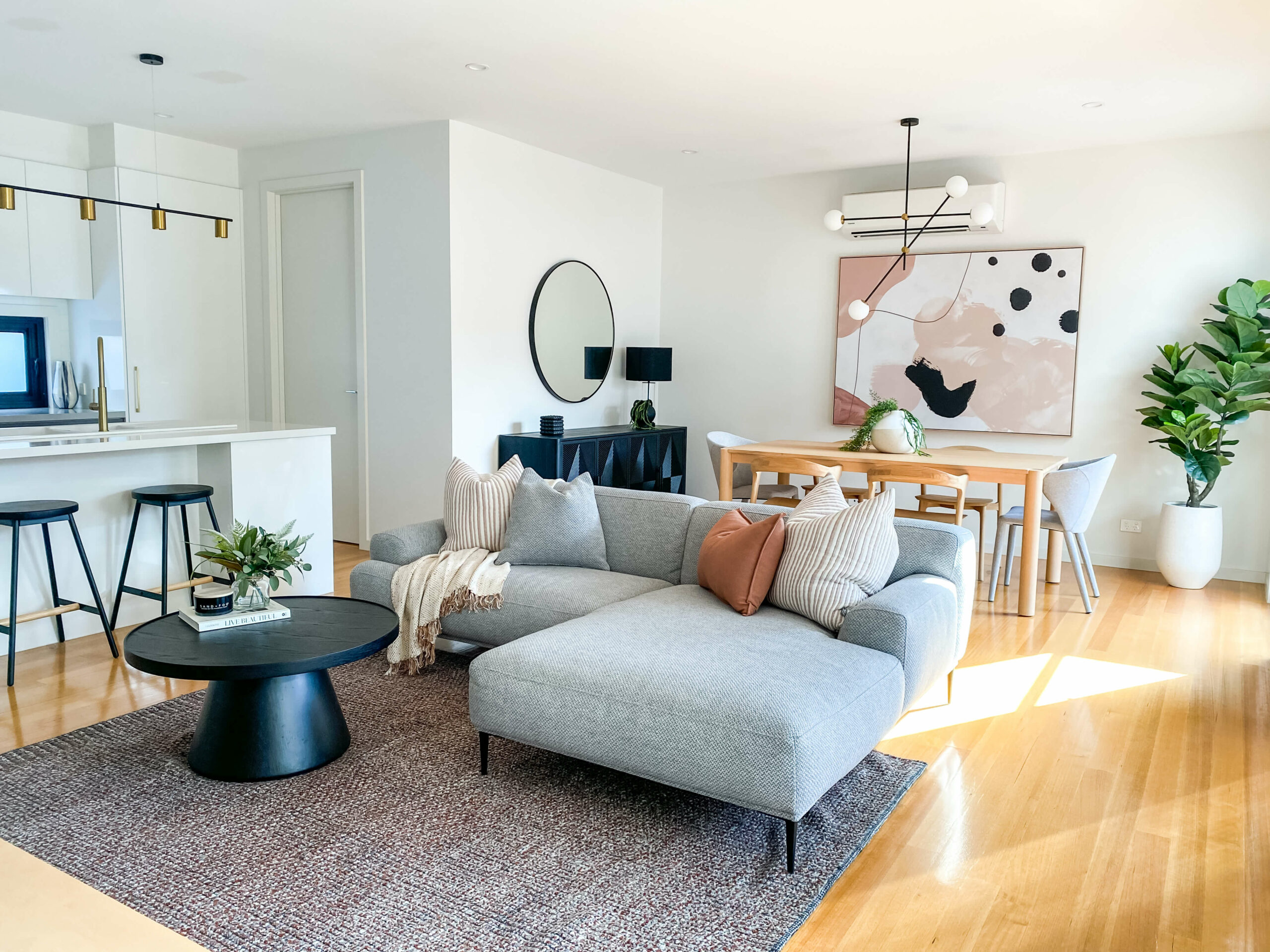
What size rug should I choose for the living room?
Choosing the size of your rug is like the story of Hansel and Gretel. You don’t want to choose too big or too small, you need to find the perfect fit.
“The easiest rule to remember is that your rug should be larger than your sofa”.
Allow an extra 30cm minimum on either side of the couch or your sofa will feel unbalanced. Any larger, your furniture will feel insignificant. The rug should cover the entire seating area to ground the conversational space.
When placing the rug, ensure that at least the front legs of your furniture are touching or sitting on top of it. In some cases, you may choose to have all furniture legs rest on the rug, but this works best in larger rooms where the rug doesn’t occupy the entire floor. This concept works particularly well in rooms with more space between the furniture and walls, creating a stylish floating effect.
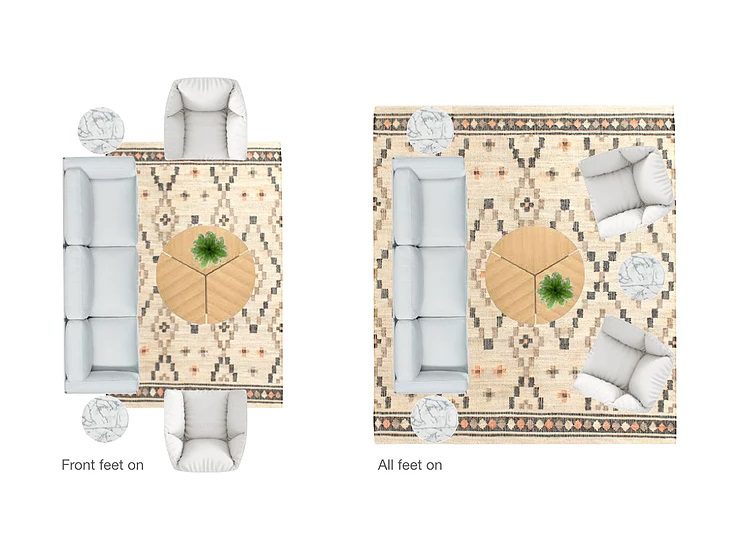
What size rug should I choose for the bedroom?
In the bedroom, size does matter 😉
The size of your bedroom will determine the size of the rug. Bigger rooms look better with bigger rugs sitting under the bed. You can either sit all of your furniture on top of the rug or start the rug just in front of the bedside tables. Make sure to allow 50cm of the rug to appear out from the bottom of the bed.
Smaller bedrooms look better with smaller-scale rugs. Use the bottom feet of the bed as the middle point for your rug. Half of the rug should be under the bed and the other half should be coming forwards.
Another option is to get 2 x runners sitting on either side of your bed, giving your feet a cosy pathway in the morning. This option can be more cost-effective in giving you the “full rug look”.

What size rug should I choose for the dining room?
As mentioned previously, a rug for the dining room isn’t for everyone. I will only choose a rug for the dining room if it is going to enhance the space or solve a design flaw (clashing wood tones, a dark room needing a lift or a large space needing some grounding).
The rug size should be chosen based on the footprint of your dining table AND chairs. Often people choose a size that fits the dining table perfectly, leaving the chairs in an awkward position to move in and out. Allow enough overhang for your chairs to comfortably sit on top of the rug and move without any interference from the rug’s edge.
The shape of your dining table should determine the shape of your rug. If you have a rectangular table, stick with a rectangular rug. If you have a round, oval or square dining table, go for a round or square rug.
What rug material should I choose?
When considering the size of your rug, your budget naturally comes into play. If you find yourself unable to afford both high-quality materials and a large-scale rug, I recommend prioritizing the size over the material. Getting the size of your rug right is the most crucial factor. Fortunately, many synthetic materials offer a comparable appeal to natural ones and are easy to maintain.
Selecting the appropriate material for your rug is another essential aspect to consider. Do you have children or pets? If so, opting for a material that is easier to clean and less prone to pulling or fraying would be wise. Are allergies a concern? In that case, it’s best to avoid rugs that accumulate dust or pollen, such as those with long pile shag. If durability is a priority, a rug incorporating a blend of natural and synthetic materials may be the optimal choice for long-lasting resilience.
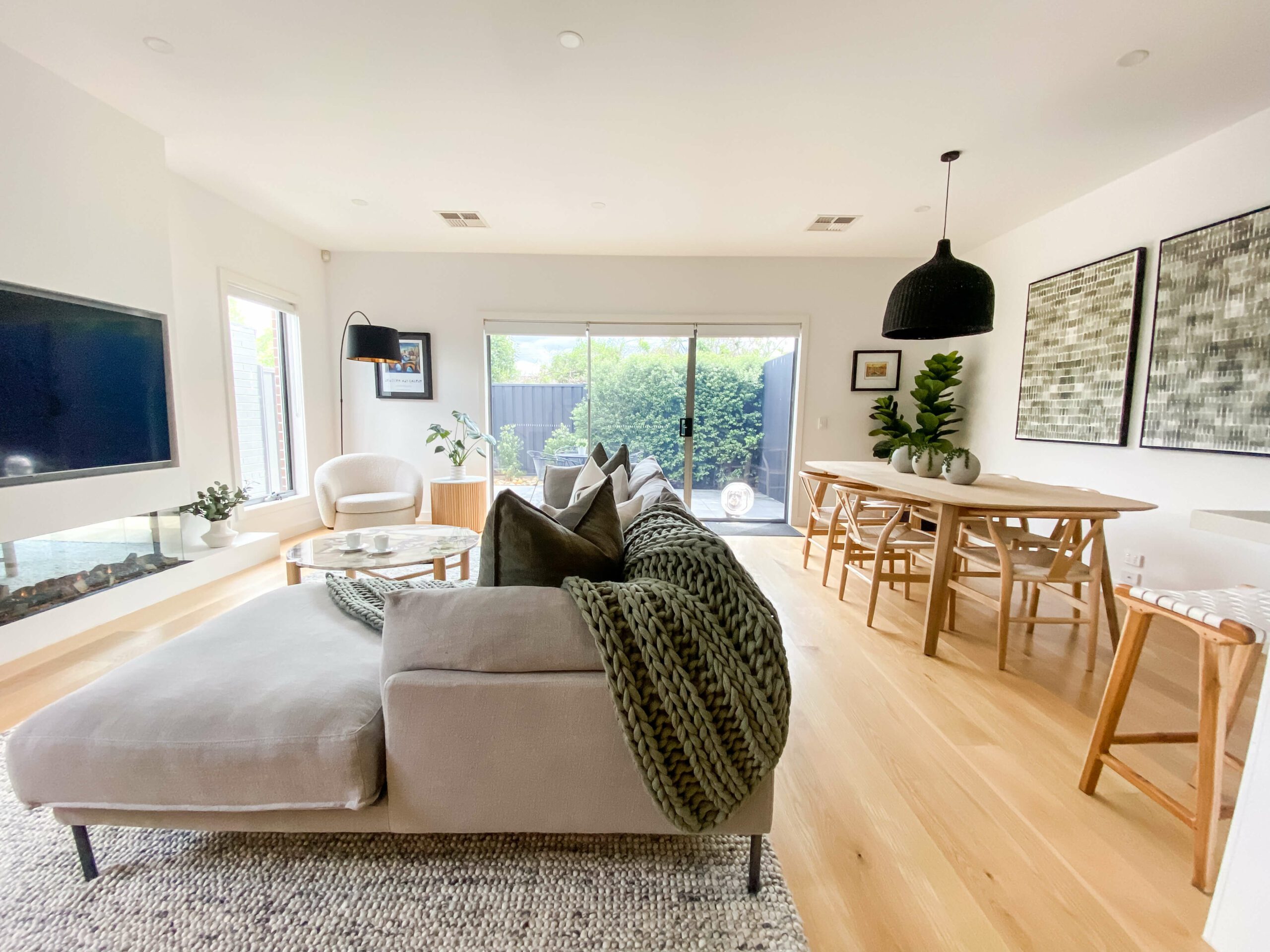
Wool
Wool rugs are popular due to several reasons. Wool, originally a sheep’s coat, offers warmth, insulation, and liquid resistance. It retains dye well, resists fading, and effectively filters air pollutants. It also absorbs and releases humidity, acting as a natural air humidifier. The “Scandinavian” style complements wool rugs beautifully.
Cotton
Cotton, a versatile plant, lends itself to various textiles like clothing, tablecloths, bed linens, and rugs. Unlike wool rugs, cotton rugs are typically thinner and less insulating, making them ideal for decorative purposes in hotter climates. Cotton is a renewable, biodegradable, and eco-friendly choice, appealing to environmentally conscious individuals. It readily absorbs dyes, allowing for intricate pattern designs. While cotton rugs may attract more dust, they are conveniently machine washable. For a perfect match, the “Hamptons” style complements this type of rug.
Silk
Silk, derived from the cocoons of silkworm larvae, is a luxurious material used to create rugs. Gathering enough silk for a rug is a time-consuming process, making it the most expensive option. Silk rugs are renowned for their softness, opulence, and captivating sheen, making them a perfect choice for formal settings. However, pure silk is highly porous and prone to staining, so blending it with wool or bamboo is recommended for enhanced durability. It’s important to note that silk rugs are less resilient and delicate, making them unsuitable for high-traffic areas. For an exquisite match, the “Hollywood Glamour” style complements silk rugs beautifully.
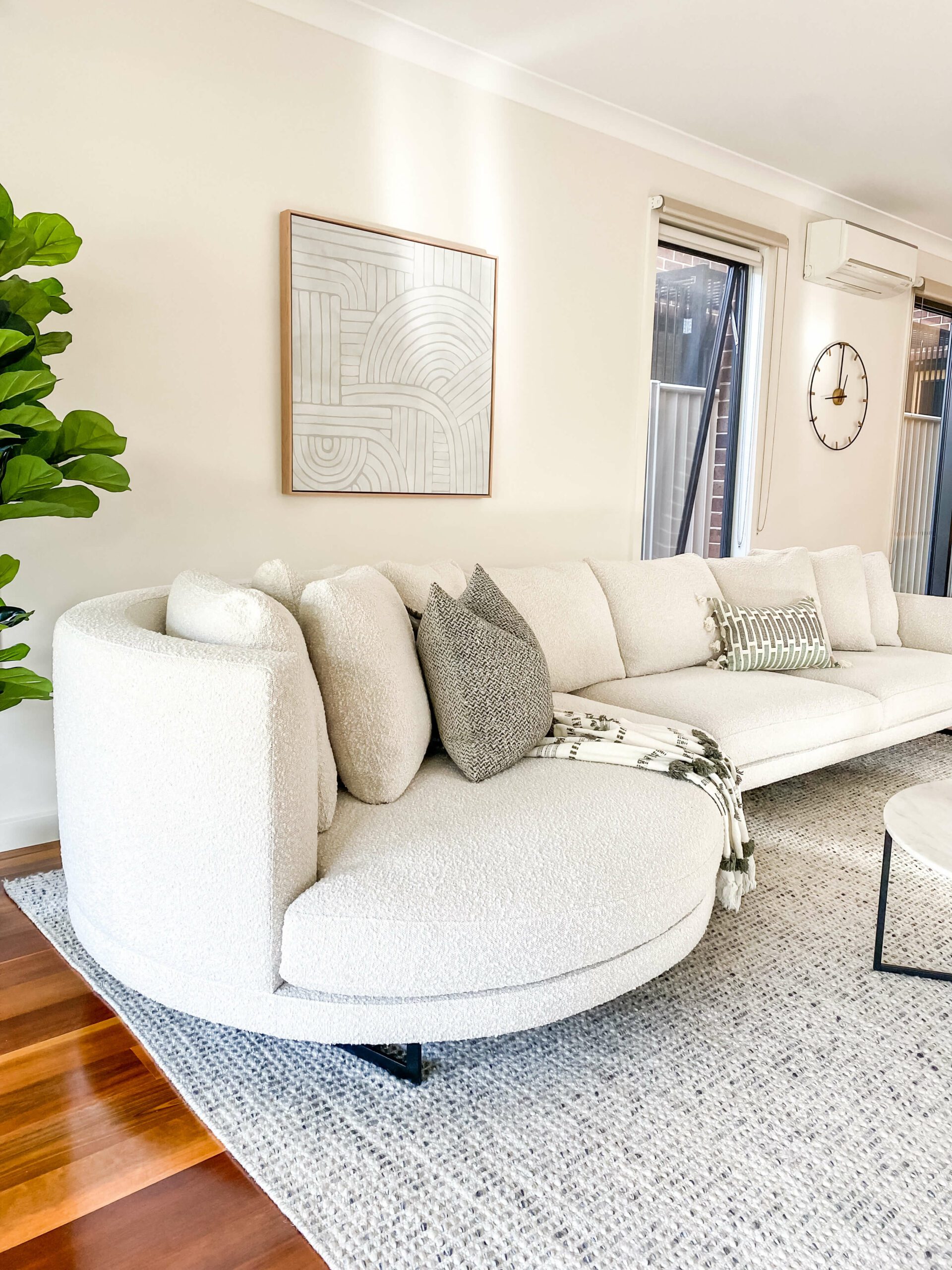
Leather
Animal hides, including cow, buffalo, zebra, alligator, etc., are used to create rugs. Among them, cowhide rugs are highly sought after. They are remarkably easy to clean, exceptionally durable, hypoallergenic, and versatile enough to be hung as well. These rugs make a bold statement and effortlessly draw attention in any room. If you desire a rug that stands out and deviates from traditional rectangular or circular shapes, a leather rug is an excellent choice. The “modern” or “Industrial” styles perfectly complement this type of rug.
Jute
Jute rugs are made from the bark of the jute plant, giving them a bristly texture. They are tough, durable, and pet-friendly, easily cleaned without chemicals. While they can withstand wear, jute is highly absorbent and prone to mold when wet, making it less suitable for humid regions. Jute rugs are commonly purchased in their raw, tanned form, which complements various interior styles. Layering jute rugs with fur creates a fantastic look, particularly within a “Boho” style interior.
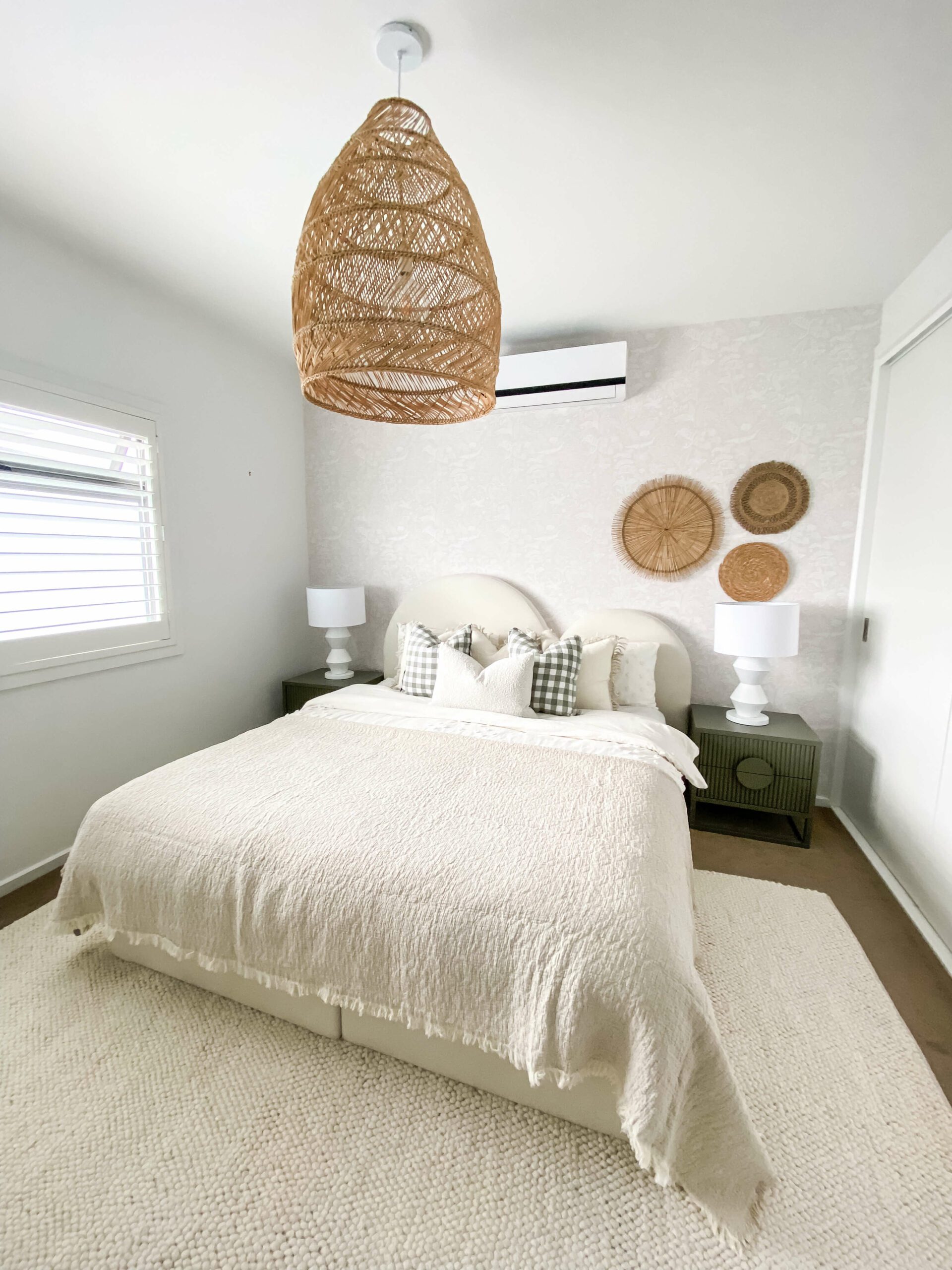
When selecting a rug, natural materials are preferable as they last longer, are easily cleaned, and are non-harmful to your respiratory system compared to synthetic fibers. While natural materials may be more expensive, opting for less harmful options is important if on a budget. Choosing something cheap now may result in higher costs when it needs replacing in the future.
Thanks for reading! I really hope you found this blog useful. Check out my other blogs HERE.
Thanks for reading!


